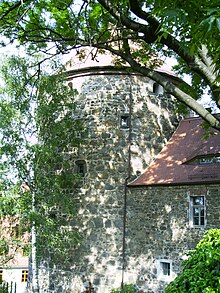Tannery Bastion
The Gerber Bastion , in Sorbian , is part of the historical fortifications in the old town of Bautzen . It secured the section between the Nicolai and Schülerturm on the north side of the city and protected the crossing of the Via Regia over the Spree and the paths into the city as well as the kennel behind the inner city wall.
Today the Bautzen youth hostel is located in the Gerberbastei .
construction
The bastion has the shape of a massive five-storey round tower made of granite quarry stone. The walls in the lower part of the tower are about 3.5 m thick. The upper three floors are provided with loopholes in all directions, while those on the lower two floors only open towards Gerberstraße (Via Regia). On the north side of the tower there is an approximately 1.5 m² sandstone relief, which shows the Bautzen city arms, but is badly damaged.
A small nave connects the tower with the kennel.
history
At the beginning of the 16th century , the Bautzen fortification system was largely complete. The Gerber Bastion, built between 1503 and 1506, is the youngest fortress in the inner ring. The name of the bastion goes back to the tanners and white tanners who lived in Gerberstrasse below the tower and were responsible for the defense of this section of the wall.
When a plague epidemic struck Bautzen in 1559 , the Gerberbastei was used as a hospital due to its slightly remote location and was nicknamed the "Infirmary" . In the 17th century the kennel between the bastion and the Nicolaiturm was used by the riflemen as a practice area. The Gerberbastei took over a. the functions of an accommodation and an arms store.
During the siege of Bautzen by the troops of Elector Johann Georg I of Saxony in 1620, both the tanners' bastion and the neighboring Nikolaikirche were badly damaged. On May 2, 1634, the bastion burned down completely during the city fire set by Colonel von der Goltz by the retreating imperial troops. The reconstruction was only completed in 1703.
In 1770 the building was changed slightly again, as it was to serve as a summer residence for a councilor from then on. During the Battle of Bautzen , the bastion was used as accommodation and horse stable as well as a location for a cannon. From 1838 to 1866 it served as a sports facility for Bautzen teachers, students and the gymnastics club.
The Gerberbastei has served its current purpose since 1917. At that time a “hostel for youth hikes” was set up here. Bautzen thus has the oldest youth hostel in Saxony . In 1996 the building was completely renovated.
swell
- ↑ The second, mainly due to the removal of the roof so that the defenders could station guns.
- ↑ The city fortifications had already been dismantled at this point in time.
- ↑ The year is unclear. Other sources speak of 1913 or 1922.
- Richard Reymann : History of the city of Bautzen , printing and publishing: Gebrüder Müller, 1902
- Eberhard Schmitt: Bautzen's monuments - The Gerberbastei , leaflet on the city's history
Web links
Coordinates: 51 ° 11 ′ 0.6 ″ N , 14 ° 25 ′ 28.4 ″ E




